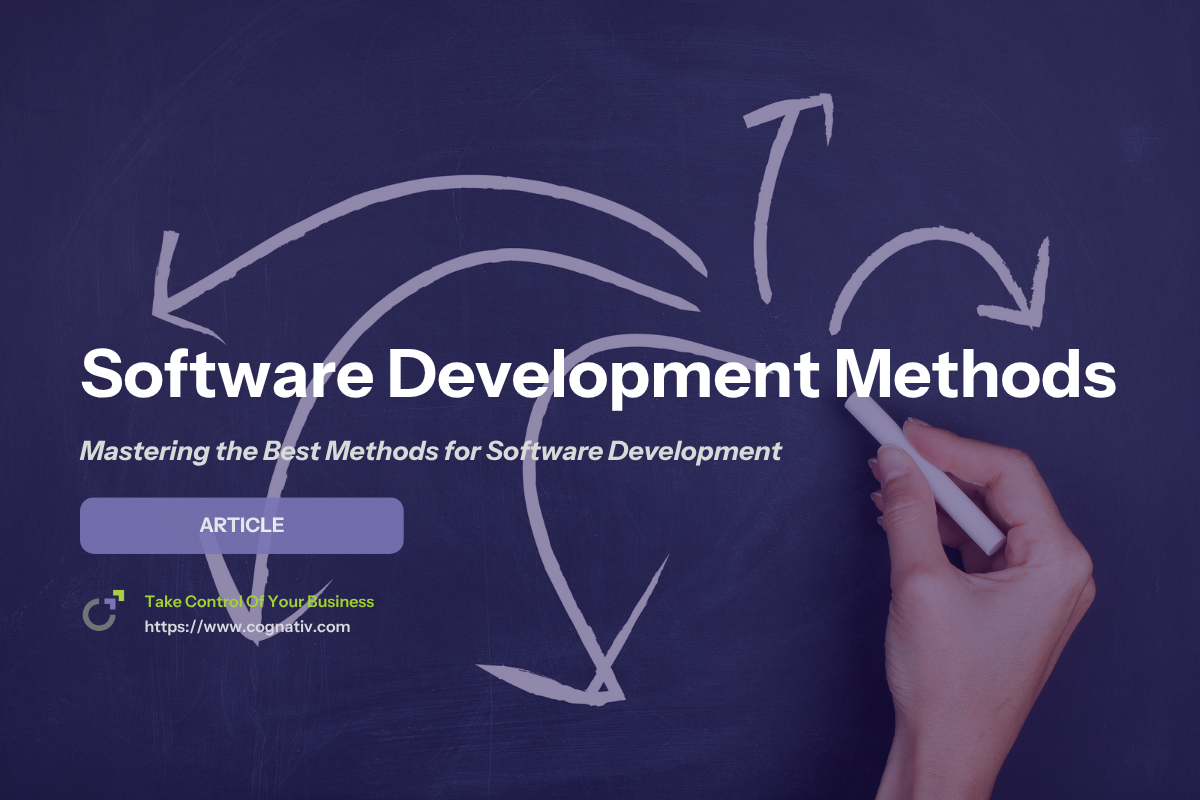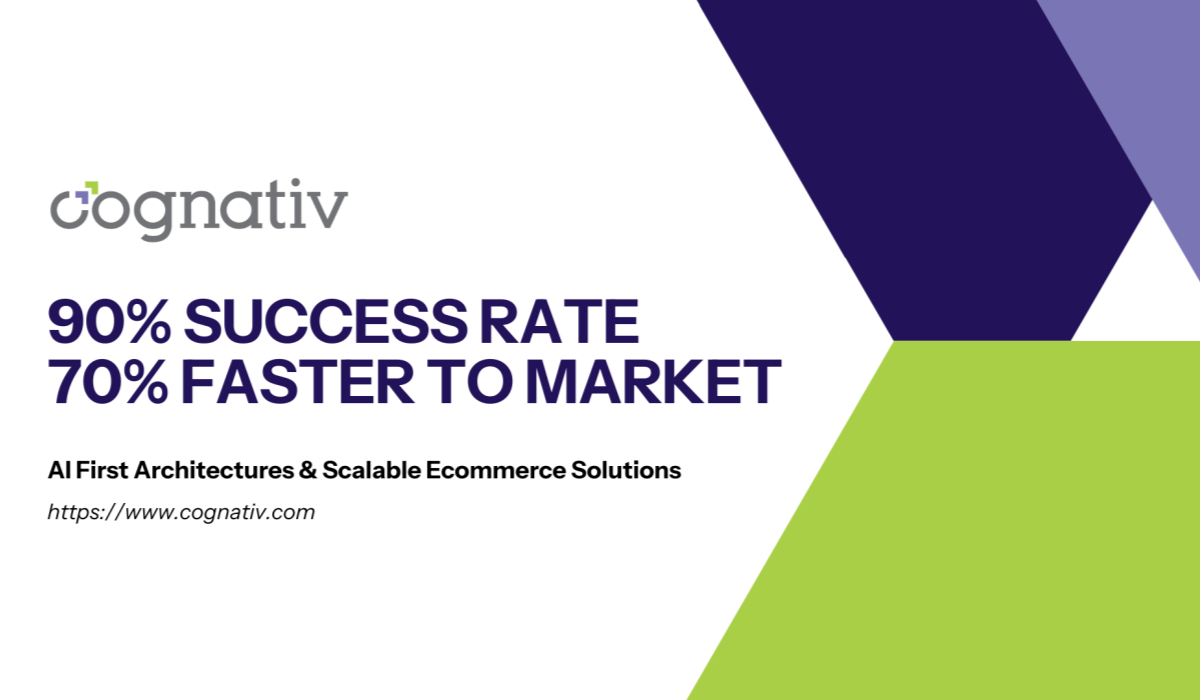Mastering the Best Methods for Software Development
Choosing the right method of software development is essential for the success of any project. This article explores various methods, explaining their strengths and weaknesses, and helps you determine which is best for your project needs.
Key Takeaways
-
Understanding and selecting appropriate software development methodologies is crucial for optimizing team performance and project outcomes.
-
The Software Development Life Cycle (SDLC) consists of seven essential phases that ensure the delivery of high-quality software, while Agile methodologies promote flexibility and responsiveness to changing requirements.
-
Measuring success through metrics and being aware of common pitfalls in software development can help teams continuously improve their processes and avoid costly mistakes.
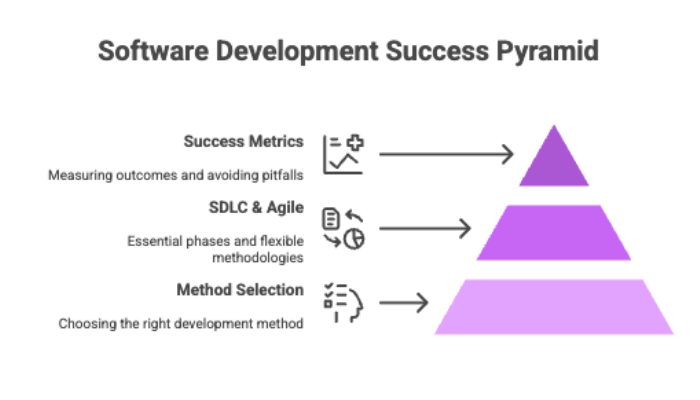

Understanding Software Development Methodologies
Software development methodologies are structured processes for software development projects, designed to streamline the creation of software products and software systems, including software applications. These methodologies provide a framework that guides the entire development process, ensuring that software engineers work efficiently and effectively to achieve their goals. These methodologies are vital for the success of development teams in the field of software engineering.
The primary goal of software development is to create a product that efficiently meets both user needs and business objectives. This is where methodologies play a crucial role, facilitating efficient teamwork and formalizing communication. Different methodologies exist due to their varying strengths and weaknesses, allowing software developers to choose the one that best aligns with their project requirements and goals. By leveraging these structured approaches, teams can enhance collaboration, achieve timely results, and stay within budget.
Selecting the appropriate software development methodology optimizes the development process and aligns it with team objectives. Team structure, requirements, and goals influence this choice. Understanding these factors helps teams select a development methods that meets their needs and maximizes their chances of success.
This foundational knowledge sets the stage for exploring the various methodologies in detail, starting with the Software Development Life Cycle (SDLC).
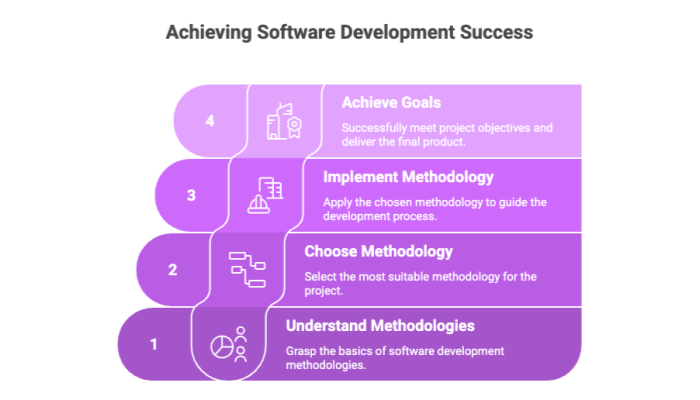

The Software Development Life Cycle (SDLC)
The Software Development Life Cycle (SDLC) is a systematic software development approach for developing software. It ensures that the software is high-quality, cost-effective, and secure.SDLC is composed of seven key phases:
-
Planning
-
Requirements Analysis
-
Design
-
Coding
-
Testing
-
Deployment
-
Maintenance
Each phase serves a distinct purpose and collectively ensures the successful delivery of a software project.
During the Planning phase, the software’s purpose, project scope, and strategies for execution are defined, laying the foundation for the entire project. The Requirements Analysis phase involves gathering and documenting user expectations through various methods such as interviews, surveys, and focus groups.
In the Design phase, the team constructs the software’s architecture and user interfaces, setting the stage for the subsequent coding phase. The Coding phase involves translating the software design into functional code, guided by the Software Design Document.
The Testing phase is crucial for examining the software for defects and ensuring it meets quality standards before deployment. Deployment represents the transition where the software is made available to users or production systems.
Finally, the Maintenance phase focuses on continuous improvement and support, addressing user feedback and software updates to maintain software applications and ensure ongoing maintenance. Following these structured stages enables teams to produce high-quality software that meets customer support response time expectations on time and within budget.
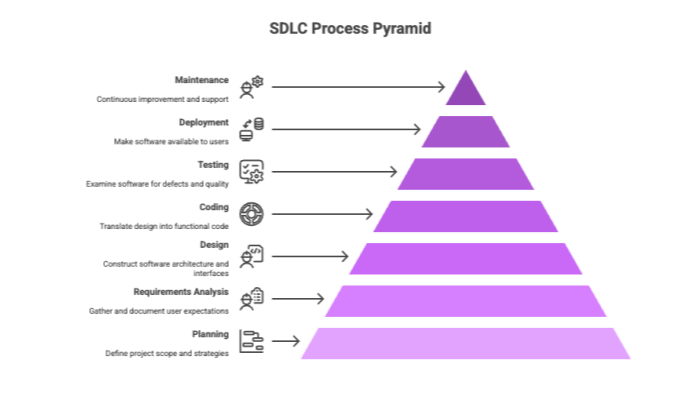

Agile Software Development
Agile software development encompasses approaches that reflect the values and principles of the Agile Alliance. It emphasizes flexibility, collaboration, and customer feedback, making it a popular choice for managing complex projects. Surveys highlight numerous benefits of agile software development and adaptive software development, such as faster delivery, better management of changing customer priorities, and increased productivity, contributing to software development agility.Agile methodologies prioritize communication among developers, customers, and users to ensure alignment on project goals. The iterative approach involves breaking larger projects into smaller sprints, allowing for frequent reassessment and adaptation using agile methods, agile development methods, agile development methodology, agile software development methodology, agile software development methodologies, and the agile model.
Each iteration concludes with a demonstration of a working product to stakeholders, showcasing progress and inviting feedback. The core values of Agile methodology and the various practices and frameworks under its umbrella will now be explored.
Core Values of Agile Methodology
The Agile manifesto encapsulates the core values of Agile methodology, prioritizing individuals and interactions over processes and tools. Agile values face-to-face conversation as the most efficient way to convey information within a development team. Direct communication fosters a collaborative environment where team members can quickly address issues and make decisions.
Team self-organization, a fundamental principle of Agile, encourages teams to take ownership of their work and team collaboration effectively. This self-organization leads to higher levels of engagement and accountability among team members. The primary measure of progress in Agile methodology is working software, reflecting the ultimate goal of delivering functional solutions.
Agile methodology prioritizes accommodating changing requirements, even late in the development process. Agile teams remain adaptable and responsive to change, recognizing the limits of planning in a turbulent environment. The agile process ensures that documentation should be sufficient to achieve goals without excessive detail, ensuring team members can quickly understand and act on project requirements in agile project management.
Agile Practices and Frameworks
Several frameworks and practices under the Agile umbrella offer unique approaches to software development. Scrum is one of the most widely used frameworks, particularly effective for projects with uncertain requirements. It relies on sprints, typically lasting up to four weeks, with key activities at the end of each sprint to review achievements and plan tasks for the next sprint. A Scrum team usually consists of a Product Owner, Scrum Master, and Development Team, each with specific roles.
Kanban is another popular Agile framework that uses visual boards to promote transparency in project workflows. Scrumban, a hybrid of Scrum and Kanban, adds flexibility in planning and prioritization, with iterations lasting up to two weeks and on-demand planning.
Extreme Programming (XP) emphasizes high-quality software delivered rapidly through practices like pair programming and test-driven development. Large Scale Scrum (LeSS) extends Scrum principles to accommodate multiple teams. This approach is ideal for larger projects that require collaboration across various teams working on the same product.
Each of these frameworks embodies the core values of Agile software development: collaboration, flexibility, and continuous improvement.
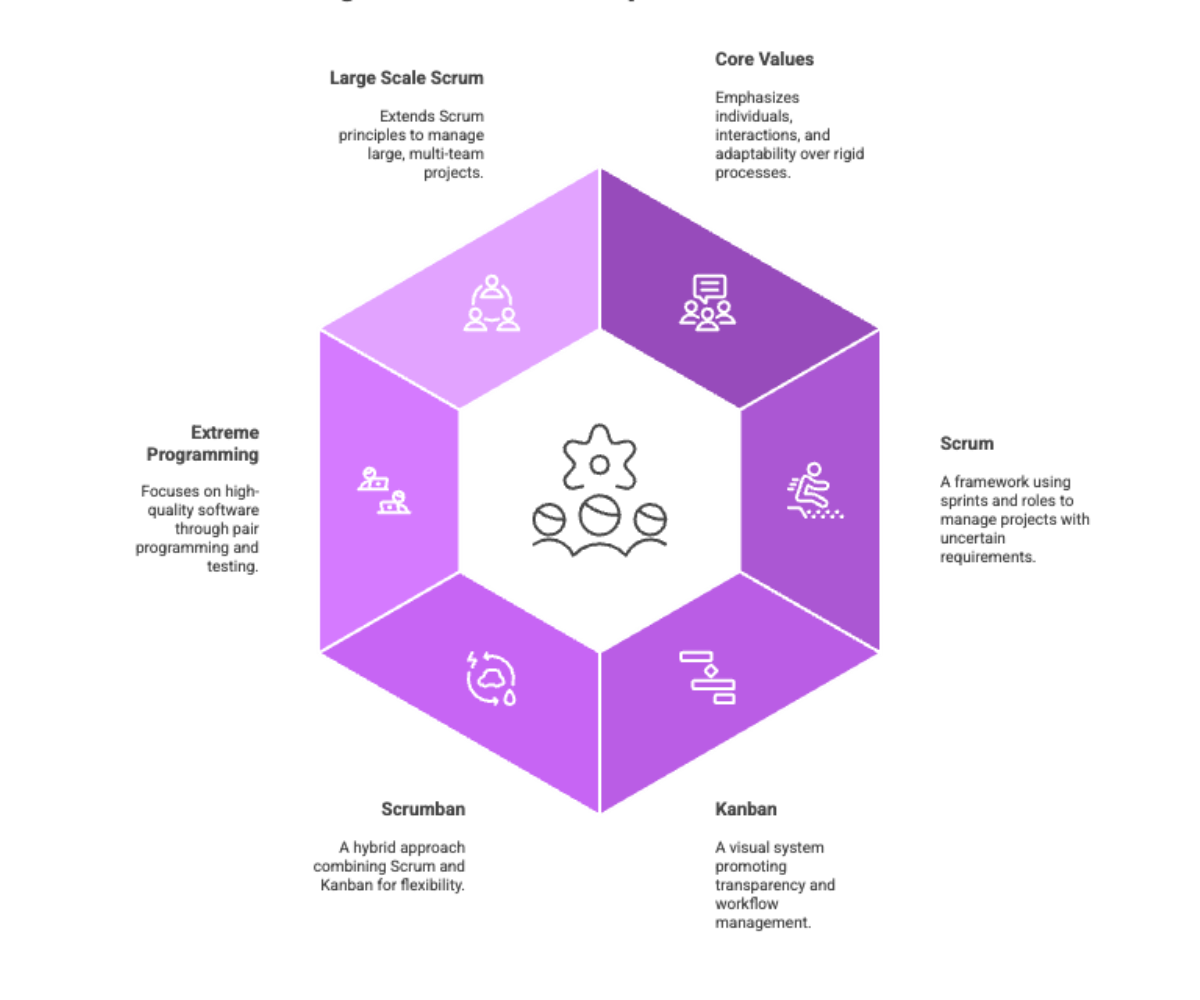

Waterfall Development Methodology
The Waterfall development methodology is a linear model with sequential phases progressing from top to bottom. This approach enhances team organization by providing clear timelines and scope, ensuring everyone understands their responsibilities and deadlines. Thorough documentation at each phase ensures smooth transitions and clarity in the project.However, the Waterfall methodology’s linear approach makes it challenging to adapt to changes throughout the development process. Testing is often postponed until after all development phases are completed, which can lead to significant issues later.
Despite these drawbacks, Waterfall is valuable for projects with well-defined objectives and stable requirements. It is best suited for small, predictable projects, often favoring a structured approach for larger and more complex projects.
Understanding the strengths and limitations of the Waterfall methodology helps teams determine when it is the most appropriate choice. This knowledge is crucial for making informed decisions and ensuring successful software delivery.
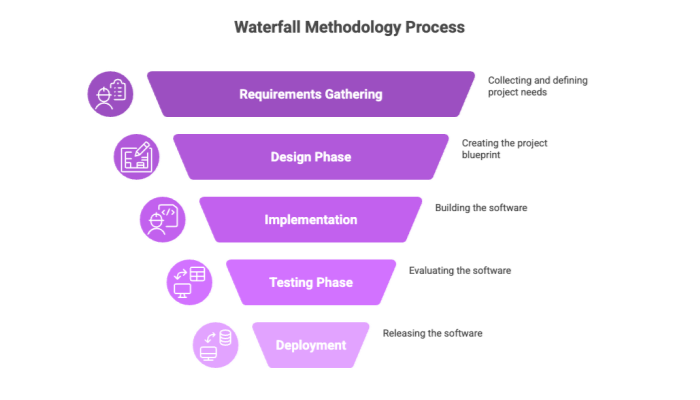

Rapid Application Development (RAD)
Rapid Application Development (RAD) was introduced by James Martin in the 1980s and focuses on faster software development cycles unlike traditional methodologies. RAD emphasizes flexibility in its development process, allowing for adjustments and new inputs at each stage. This approach prioritizes delivering functional prototypes frequently to gather real-world user feedback, enabling teams to make rapid adjustments based on user needs.
Implementing RAD successfully requires a small, skilled team with effective communication and adaptability to user feedback. The RAD methodology consists of five phases: Business modeling, Data modeling, Process modeling, Application generation, and Testing. These phases are aimed at delivering a refined product rapidly, ensuring that the final software meets user expectations and business objectives.
Adopting RAD accelerates development cycles, reduces time to market, and improves user satisfaction. This methodology is particularly beneficial for projects that require quick turnaround times and frequent updates based on user feedback.
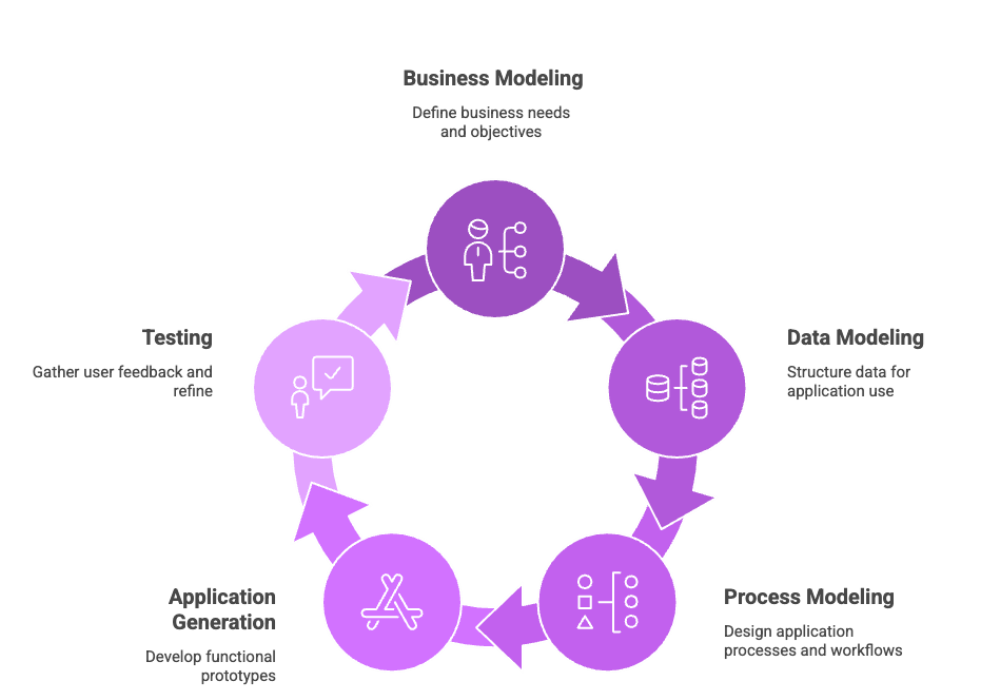

DevOps and Continuous Integration
DevOps is a set of practices that promotes collaboration between development and operations teams. This collaborative approach breaks down silos, aligning all stakeholders throughout the software development lifecycle. Continuous integration, a key practice within DevOps, involves developers integrating small, manageable chunks of code regularly. Frequent integration aids in early bug identification and resolution, resulting in higher overall code quality.
Automating integration allows for faster software updates, streamlining deployment. Continuous integration provides rapid feedback on code changes, facilitating quick adjustments by developers. This practice not only enhances the efficiency of the development process but also ensures that the software is reliable and of high quality through continuous delivery.
Documentation of build and deployment processes is essential for knowledge sharing and troubleshooting in continuous integration. Comprehensive documentation customer collaboration ensures everyone is on the same page and issues can be quickly resolved. With its focus on collaboration and continuous improvement, the DevOps approach is a powerful methodology for efficient, high-quality software delivery, supported by detailed documentation.
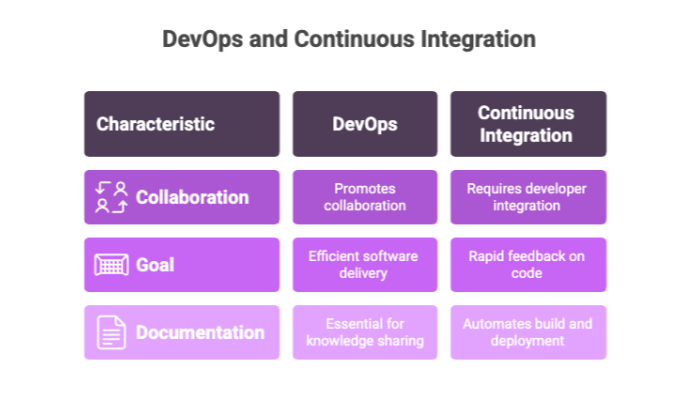

Incremental Development
Incremental development focuses on developing software in small, manageable sections called increments. This model works well for projects that need quick delivery of essential features and aligns with feature driven development. It also supports ongoing user feedback. Breaking development into smaller, stand-alone parts enables better management and control of the process.
One major advantage of incremental development is the early detection of potential issues, which can minimize costly errors later in the development process. The Incremental Model allows for early release of core functionalities, facilitating user feedback and rapid adjustments. Incremental development’s flexibility makes it easier to implement changes based on user feedback during the process.
Incremental development can be classified into two main types of software development: Staged Delivery Model, which sequentially delivers functional parts, and Parallel Development Model, where different teams work on multiple components simultaneously. Effective incremental development requires careful and strict planning of increments to ensure smooth progress and integration. This approach keeps teams agile and responsive to changing project requirements.
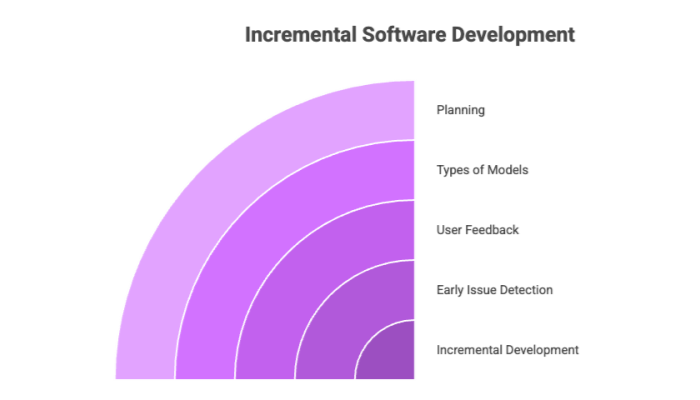

Spiral Model
The spiral model focuses on iterative risk assessment, combining sequential and iterative approaches to facilitate incremental software development. In this model, development occurs in cycles or spirals, allowing teams to analyze, test, and modify software progressively. This iterative approach ensures that any risks are identified and addressed early in the development process, making it particularly useful for large, complex projects with evolving requirements.
At the end of each cycle in the spiral model, the software’s alignment with defined requirements is evaluated, ensuring continuous improvement. Repeatedly assessing and refining the software allows teams to produce a final product that meets user needs and business objectives.
The spiral model’s focus on risk management and iterative development makes it a robust approach for complex projects.
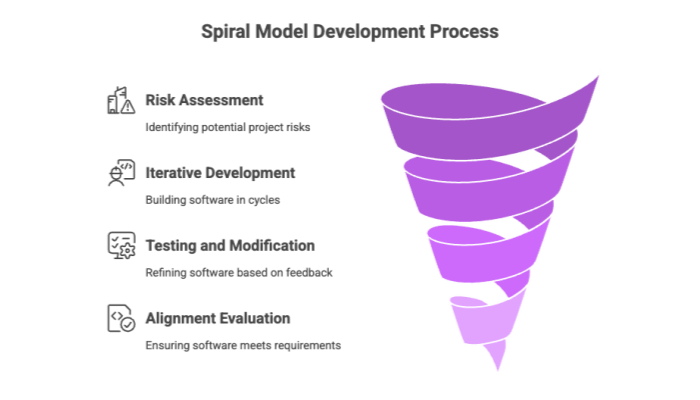

Choosing the Right Software Development Methodology
Selecting the right software development methodology is crucial for any project’s success. Understanding project constraints like budget and time is key to selecting a suitable methodology. Underestimating time and resources often leads to delays and quality compromises, necessitating realistic project planning. A well-chosen methodology aligns the development process with business goals, providing clear direction and enhancing efficient project management.There is no single best software development methodology; rather, it is important to combine elements that work best for the team and project. Agile methodologies like Scrum or Lean are often recommended for startups as they allow quick adaptation to changes and resource-efficient prototyping. Effective risk management is another benefit of choosing the right methodology.
Assessing stakeholder expectations early ensures the chosen methodology meets diverse priorities. Factors influencing methodology choice include team structure, experience, project requirements, goals, budget, and other underlying elements. Carefully considering these factors helps teams choose a methodology that maximizes their chances of success and ensures high-quality software delivery.
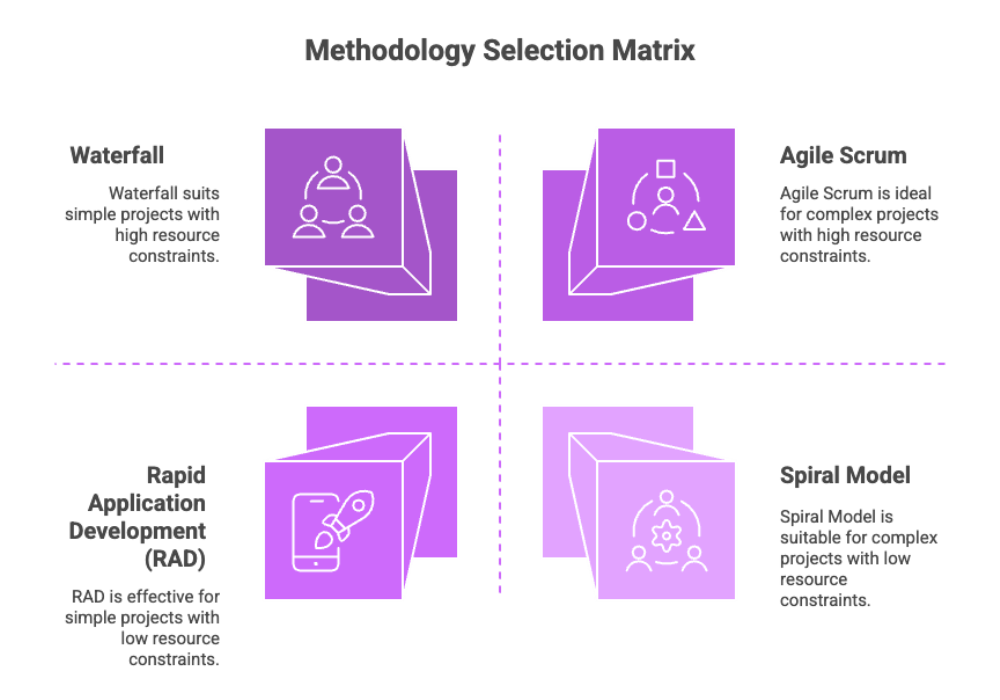

Metrics for Measuring Software Development Success
Metrics are critical for evaluating success and ensuring projects meet quality standards in software development. Quality metrics defect density quantifies the number of defects per thousand lines of code, indicating software quality during development. Efficiency metrics lead time for changes measures the duration from code commit to deployment, reflecting development process efficiency.
User satisfaction gauges how well a software product meets user needs, often assessed through surveys and other feedback tools. Release frequency indicates how often new software versions are delivered, showcasing responsiveness to user demands. Lack of quality assurance can result in defects and usability issues, underscoring the need for systematic testing and feedback mechanisms to enhance customer satisfaction metrics and customer satisfaction.
Insufficient testing can lead to undetected flaws and security vulnerabilities, highlighting the need for comprehensive strategies. Leveraging these metrics allows teams to continuously improve their development processes, ensuring the delivery of high-quality software that meets user expectations through rigorous testing and automated testing.
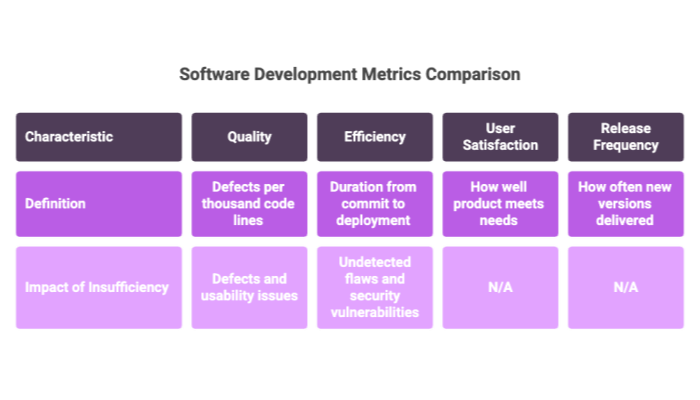

Common Pitfalls in Software Development
In software development, several common pitfalls can derail a project if not addressed properly. Focusing solely on new functionality in agile development can lead to increased technical debt and long-term maintenance issues. Implementing agile without sponsor support can create difficulties with business partners and resistance from management, underscoring the need for organizational buy-in.
Improperly filling the product owner role in agile can cause distraction and collaboration breakdowns, affecting overall team productivity. Agile practices may face inefficiency challenges in large organizations due to legacy infrastructure and large-scale development issues.
The Waterfall methodology, with its rigidity and sequential phases, can be slow and costly, making it less suitable for flexible and rapid iteration projects. Awareness of these pitfalls allows teams to take proactive measures to mitigate risks and ensure successful software project delivery. Understanding these challenges allows teams to refine their development processes and avoid costly mistakes.
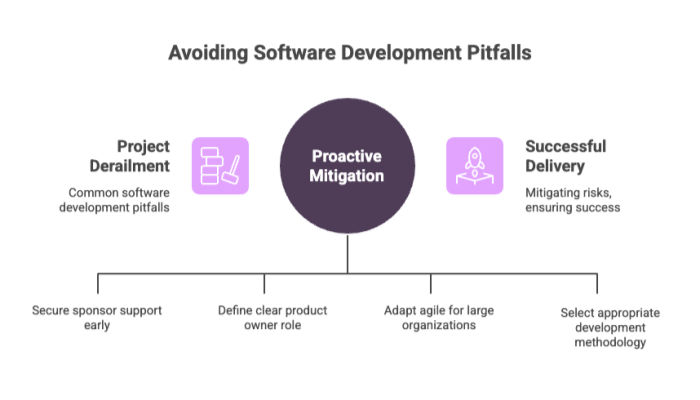

Applications Beyond Software Development
Agile methodologies extend beyond software development to fields like project management, innovation, and managing non-software products like medical devices, food, and clothing. Agile’s iterative nature encourages rapid feedback, enabling teams to respond quickly to changing demands across various fields. Agile principles have been applied in household management and child development, demonstrating their versatility in organizational contexts.
Lean development, another methodology rooted in software development, focuses on minimizing waste and increasing efficiency. These principles can enhance operations outside of software, improving performance and productivity. Adapting software development methodologies to diverse industries fosters greater adaptability and efficiency.
The versatility and adaptability of agile processes and Lean methodologies make them powerful tools for driving innovation and efficiency across various domains. By applying these principles beyond software development, organizations can achieve significant improvements in their processes and outcomes.
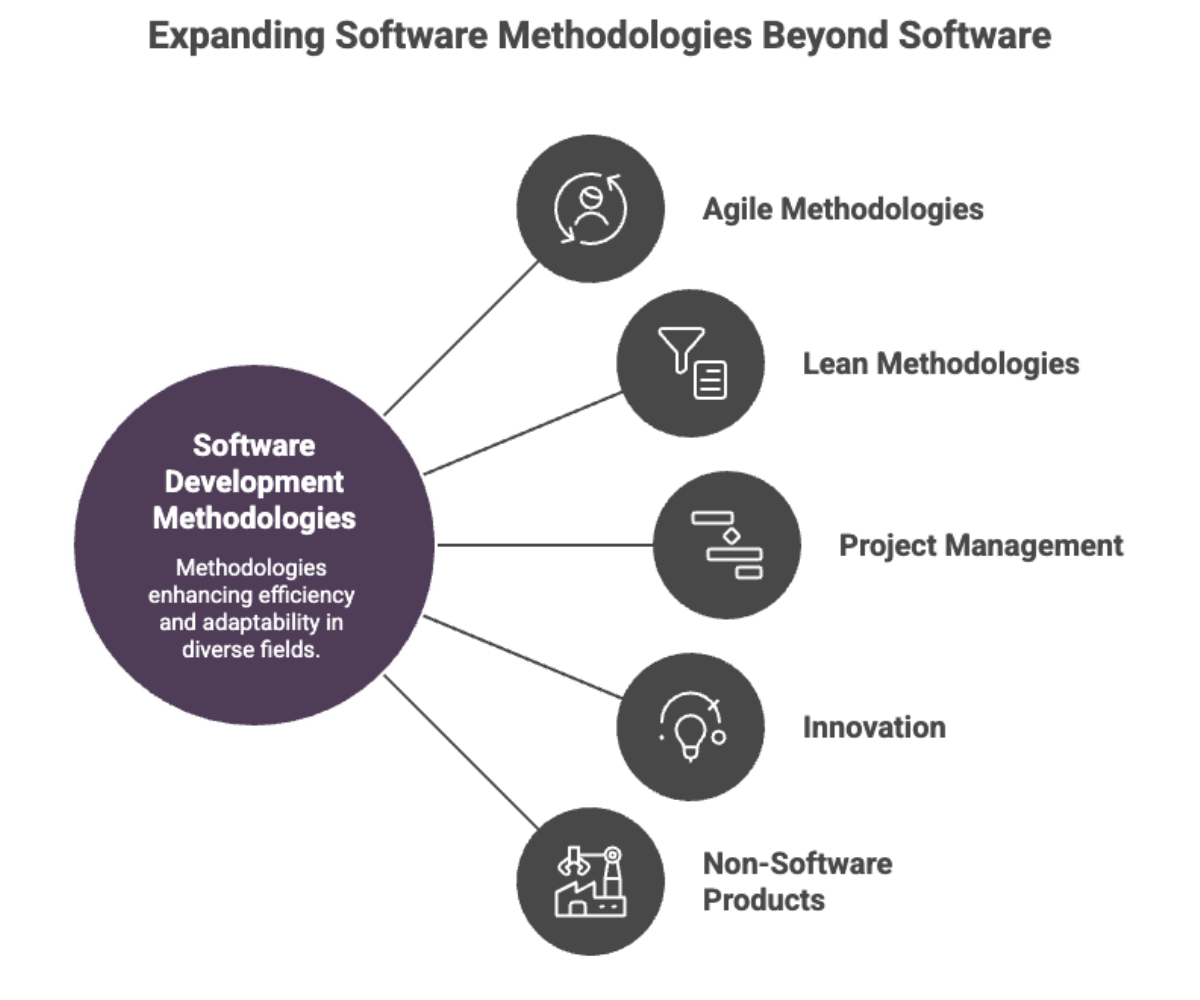

Summary
Throughout this journey, we’ve explored various software development methodologies, each with its unique strengths and challenges. From the structured approach of the Software Development Life Cycle (SDLC) to the flexibility of Agile and the rapid iteration of Rapid Application Development (RAD), each methodology offers valuable insights for optimizing the development process. By understanding these methodologies, teams can choose the right approach for their projects, ensuring the delivery of high-quality software that meets user needs and business objectives.
Choosing the right methodology is crucial for aligning the development process with project goals, managing risks, and ensuring efficient workflow. Metrics for measuring software development success, such as defect density and user satisfaction, provide valuable feedback for continuous improvement. By being aware of common pitfalls and understanding the versatility of Agile methodologies beyond software development, teams can refine their processes and achieve greater success.
As we conclude this journey, we encourage you to apply the knowledge gained to your projects, continuously refine your methodologies, and stay adaptable to changing demands. The future of software development is bright, and with the right approach, you can navigate the complexities of this dynamic field with confidence and success.

Frequently Asked Questions
This FAQ section addresses common queries about the method of software development, covering essential topics such as the software development process, project management frameworks, and behavior driven development. Whether you're new to software engineering or looking to refine your agile software development knowledge, these answers provide clear insights into key concepts and best practices that support successful software development projects.
What are the key phases of the Software Development Life Cycle (SDLC)?
The key phases of the Software Development Life Cycle (SDLC) are Planning, Requirements Analysis, Design, Coding, Testing, Deployment, and Maintenance. Each phase is essential for effective software development and successful project completion.
How does Agile methodology handle changing requirements?
Agile methodology effectively embraces changing requirements by prioritizing flexibility and adapting to users' needs throughout the development process. This approach guarantees that the final product aligns closely with user expectations and market demands.
What is the primary measure of progress in Agile software development?
The primary measure of progress in Agile software development is working software, which signifies the successful delivery of functional solutions to meet user needs.
What are the benefits of using metrics in software development?
Using metrics in software development enhances the evaluation of success, guarantees adherence to quality standards, and facilitates ongoing improvement through actionable feedback. This leads to more efficient processes and better overall project outcomes.
Can Agile methodologies be applied outside of software development?
Agile methodologies can indeed be applied outside of software development, as they are effective in project management, innovation, and the management of non-software products. This versatility allows organizations to enhance efficiency and adaptability across various domains.

